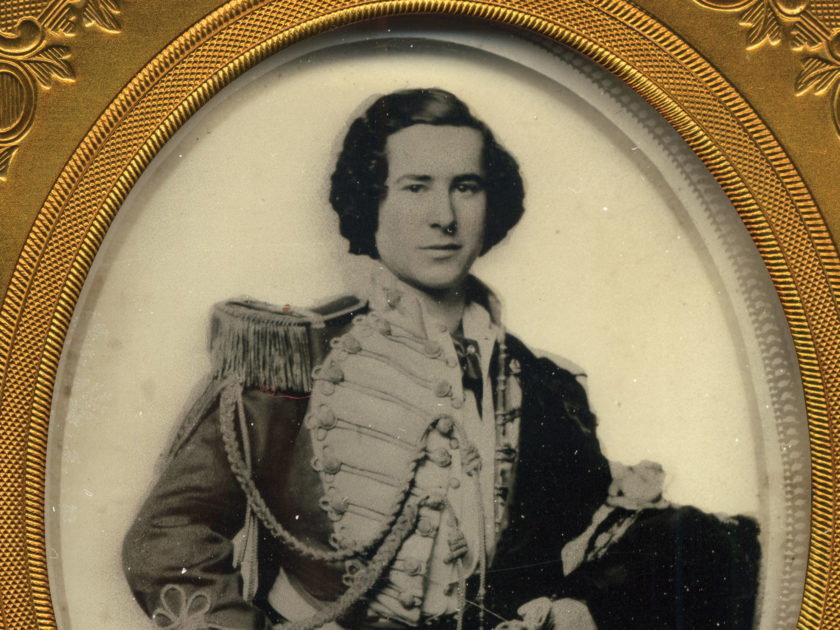By Ron Field, Michael J. McAfee, and Ronald S. Coddington
Had the Civil War not taken place, Elmer Ephraim Ellsworth might have been best remembered as the visionary brainchild behind the U.S. Zouave Cadets. The bankrupt militia company he reimagined after he took over in the spring 1859 became the renowned drill team that electrified audiences across the country the following summer with precision parade-ground maneuvers. Its members, attired in flamboyant French Algerian-inspired military uniforms that were trending in American militias, left throngs of envious men and breathless ladies in its wake.
Thanks to the intense public interest and subsequent media focus, a wealth of illustrations and descriptions of Ellsworth’s uniforms exist. One full-color illustration is of particular interest. Produced by a lithographer from the Cadets home base of Chicago, the print pictures proposed designs for campaign and full-dress uniforms. Though the designs were not adopted, they did inspire the original uniforms for the 11th New York Infantry, or Fire Zouaves, a regiment organized by Ellsworth in 1861.

The illustration also includes descriptive text that traces the history of the proposed uniforms. “These designs are the result of a series of experiments, with different styles of uniforms, extending through a period of five years. The value and expediency of each peculiarity of the European and American uniforms has been tested in detail and submitted to the mature judgment of officers whose long experience in active service had qualified them to judge of what would best secure the greatest degree of comfort and convenience to the soldier.”
The designer, of course, was Ellsworth. The text states that he conducted the experiments, but does not provide specifics nor how much money he invested. Did he rely on sketches? Or did he hire a tailor to make samples based on his drawings and perhaps mockups?
Maybe Ellsworth wore his experiments. This might explain the uniform in which he is dressed in this previously unknown ambrotype now in the collection of Steve Meadow, who operates War of the Rebellion.com.

The uniform is extremely elaborate, even for the antebellum period. The blind button holes on the cuffs, extensive use of trefoil loops, heavy braid and epaulettes verge on the theatrical. And yet this is very much Ellsworth, who had a flair for the dramatic. He was a showman and a patriot.
The date that he sat for this portrait is not exactly known. But there are clues to help estimate the timeframe. They include the star on his tall collar, which suggests that Ellsworth was an officer. His clean-shaven face is consistent with his pre-Civil War look.
The sixth-plate ambrotype was produced in the relievo technique. According to Charles Schwartz, a founding member of the Daguerreian Society, a relievo ambrotype, also known as a white ambrotype, “was made in the usual way, but only the subject matter was varnished black (on the back side), and the whole background was carefully scraped away. Behind the picture was placed a piece of glass backed by white card. The photograph, being not quite in contact with the backing, cast a slight shadow on it, causing the figure to stand out in relief.” The technique was introduced in Scotland in 1854 and made its way to America at some point.
All things considered, one theory has emerged as a favorite with MI Senior Editor Ron Field. Ellsworth wears a specially tailored uniform of his own design, conceived of and worn in 1858 while he served as major on the staff of Brig. Gen. Jean Baptiste Beaubien of the Illinois State Militia. This is a year prior to his involvement with the National Guard Cadets, which he reformed as the U.S. Zouave Cadets.
Field observes, “Ellsworth was fond of designing his own uniforms and this might be one of those.” He adds, “He was a major of the Rockford City Greys by 1858 so this uniform could belong to that period, although the coat looks like it might have been blue rather than grey.”
MI Senior Editor Mike McAfee believes that as a staff officer he would have great latitude in how he wore his uniform. “It would have given him a chance to really put it out there without regard for a prescribed dress.” He also notes that the uniform “was throwback to an antique style, not at all progressive in design,” which calls into question how much influence it had on later designs. It may also suggest that this is one of his earliest designs.
Both men agree that this unusual uniform does not connect with his dress while in command of the U.S. Zouave Cadets. It is also dissimilar to the relatively conventional uniform he wore as colonel of the 11th New York Infantry.
On May 24, 1861, Ellsworth was shot dead by innkeeper James Jackson as he attempted to haul down a Confederate flag from the roof of the Marshall House Hotel in Alexandria, Va.
Had Ellsworth survived the shooting and the war, he might have left behind a memoir or other writing that mentions his unusual dress. But he did not, and its exact place in history and the evolution of Ellsworth’s design aesthetic remains a mystery.
Ron Field and Michael J. McAfee are Senior Editors of MI. Ronald S. Coddington is Editor and Publisher.
SPREAD THE WORD: We encourage you to share this story on social media and elsewhere to educate and raise awareness. If you wish to use any image on this page for another purpose, please request permission.
LEARN MORE about Military Images, America’s only magazine dedicated to showcasing, interpreting and preserving Civil War portrait photography.
VISIT OUR STORE to subscribe, renew a subscription, and more.

